句子成分和结构
句子成分与句子结构

• 1. Games played yesterday in their room the children quietly. • 2. Well the man the piano played. • 3. This morning a book I from the library borrowed. • 4. A new school built they in our village last year. • 5. She a letter from her brother last week received. • 6. The little boy an apple this morning ate greedily in the kitchen.
It was obvious that he was very embarrassed.(主语后置) • It is + n./adj./ v-ed + that • 据说他明天要来武汉。 • 学好英语很重要。 • 他没能通过考试真的很遗憾。 • 众所周知,中国是世界上最大的发展中国家之一。
1.2 谓语 谓语说明主语的动作、状态或特征。谓语永远只能 由动词构成。
1.5 状语 状语可修饰动词、形容词或者全句,可以由副词、 介词短语、分词短语或者动词不定式构成。 He is listening to the teacher carefully.
It won’t be long before we know the truth.
1.6 补语 所谓补语,即下面的这个结构: v+ n.十n. / adj.中的n. / adj.部分。
句型二:主语+系动词+表语
系动词的构成: 1. be动词 2. 感官动词(seem,look,taste,sound`) 3. 其他系动词 表示动作的持续和变化(keep, remain,come,go,become, get``) 4. 表示“看起来像”(look,
句子成分和结构
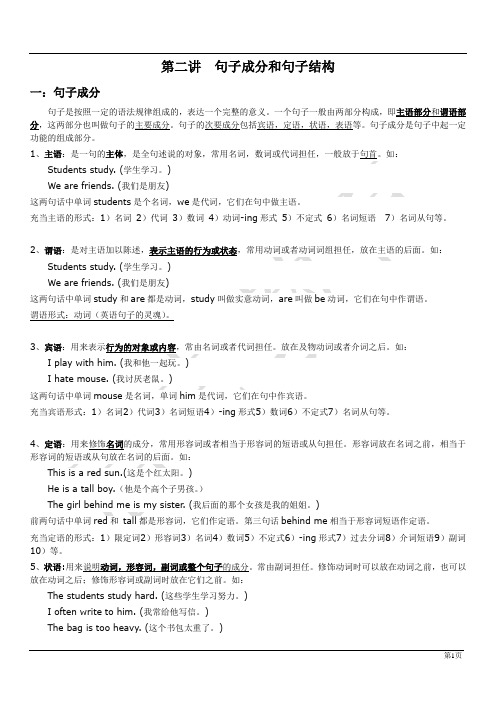
第二讲句子成分和句子结构一:句子成分句子是按照一定的语法规律组成的,表达一个完整的意义。
一个句子一般由两部分构成,即主语部分和谓语部分,这两部分也叫做句子的主要成分。
句子的次要成分包括宾语,定语,状语,表语等。
句子成分是句子中起一定功能的组成部分。
1、主语:是一句的主体,是全句述说的对象,常用名词,数词或代词担任,一般放于句首。
如:Students study. (学生学习。
)We are friends. (我们是朋友)这两句话中单词students是个名词,we是代词,它们在句中做主语。
充当主语的形式:1)名词2)代词3)数词4)动词-ing形式5)不定式6)名词短语7)名词从句等。
2、谓语:是对主语加以陈述,表示主语的行为或状态,常用动词或者动词词组担任,放在主语的后面。
如:Students study. (学生学习。
)We are friends. (我们是朋友)这两句话中单词study和are都是动词,study叫做实意动词,are叫做be动词,它们在句中作谓语。
谓语形式:动词(英语句子的灵魂)。
3、宾语:用来表示行为的对象或内容,常由名词或者代词担任。
放在及物动词或者介词之后。
如:I play with him. (我和他一起玩。
)I hate mouse. (我讨厌老鼠。
)这两句话中单词mouse是名词,单词him是代词,它们在句中作宾语。
充当宾语形式:1)名词2)代词3)名词短语4)-ing形式5)数词6)不定式7)名词从句等。
4、定语:用来修饰名词的成分,常用形容词或者相当于形容词的短语或从句担任。
形容词放在名词之前,相当于形容词的短语或从句放在名词的后面。
如:This is a red sun.(这是个红太阳。
)He is a tall boy.(他是个高个子男孩。
)The girl behind me is my sister. (我后面的那个女孩是我的姐姐。
)前两句话中单词red和tall都是形容词,它们作定语。
句子成分和句子结构

句子成分组成句子的各个部分叫句子成分。
英语句子成分有主语.谓语.表语.宾语.宾语补足语.定语.状语等。
顺序一般是主语,谓语.宾语,宾语补足语,而表语,定语,状语的位置要根据情况而定。
1、主语主语表示句子主要说明的人或事物,一般由名词.代词.数词.不定式等充当。
He likes watching TV. 他喜欢看电视。
2、谓语谓语说明主语的动作,状态或特征。
一般可分为两类:1)简单谓语: 由动词(或短语动词)构成。
可以有不同的时态,语态和语气。
We study for the people.我们为人民学习。
My sister is a nurse.我姐姐是护士。
2)复合谓语:情态动词+动词I can speak a little English.我可以说一点英语。
3、宾语宾语表示动作行为的对象,跟在及物动词之后,能作宾语的有名词,代词,数词,动词不定式等。
We like English.我们喜欢英语。
有些及物动词可以带两个宾语,往往一个指人,一个指物,指人的叫间接宾语,指物的叫直接宾语。
He gave me some ink.他给了我一点墨水。
有些及物动词的宾语后面还需要有一个补足语,意思才完整,宾语和它的补足语构成复合宾语。
如:We make him our monitor.我们选他当班长。
4、表语表语是用来说明主语的身份、性质、品性、特征和状态的,表语常由名词、形容词、副词、介词短语、不定式、动词的-ing、从句来充当,它常位于连系动词(be, become, appear, seem 等)之后。
Africa is a big continent.非洲是个大洲。
I feel much better today.我今天感觉好多了。
5、定语在句中修饰名词或代词的成分叫定语。
用作定语的主要是形容词,代词,数词,名词,副词,动词不定式,介词短语等。
形容词,代词,数词,名词等作定语时,通常放在被修饰的词前面。
《句子成分和结构》课件

04
主语的作用是明确句子 的主题,使句子更加清 晰易懂。
谓语
谓语是句子中描述主 语动作或状态的成分 。
谓语的作用是表达主 语的动作或状态,使 句子更加完整和有意 义。
谓语通常紧跟在主语 之后,由动词或动词 短语充当。
宾语
01
02
03
04
宾语是句子中接受动作或行为 的对象。
宾语可以由名词、代词或名词 短语充当。
《句子成分和结构》ppt课件
目录
CONTENTS
• 句子成分 • 句子类型 • 句子结构 • 句子分析方法 • 常见错误分析
01
CHAPTER
句子成分
主语
01
主语是句子的主要成分 ,表示句子所描述的对 象。
02
主语通常出现在句子的 开始位置,由名词、代 词或名词短语充当。
03
主语可以由一个或多个 词语组成,但必须保持 语法上的正确性。
宾语可以出现在句子的任何位 置,但通常紧跟在谓语之后。
宾语的作用是明确动作或行为 的对象,使句子更加完整和有
意义。
状语
状语是句子中描述动作发生的时间、 地点、方式等附加信息的成分。
状语通常紧跟在宾语之后,放在句子 的末尾。
状语可以由副词、介词短语或从句充 当。
状语的作用是提供更多的细节信息, 使句子更加生动和具体。
缺点
对于一些复杂的句子,成分分 析可能会变得繁琐和复杂。
层次分析法
定义
层次分析法是一种将句子按照词语之间的层次关系进行分析的方法。
步骤
首先将句子中的词语按照层次关系进行排列,然后分析每个词语在整 个句子中的作用和意义。
优点
能够清晰地展示词语之间的层次关系,有助于理解句子中的语法结信息或表达不确定的态度,例如“你来自哪里?”、“你喜欢什么音乐?”等。疑问句通 常包括疑问词、助动词和主语等成分,用以构成问题的语气和内容。
句子成分和句子结构
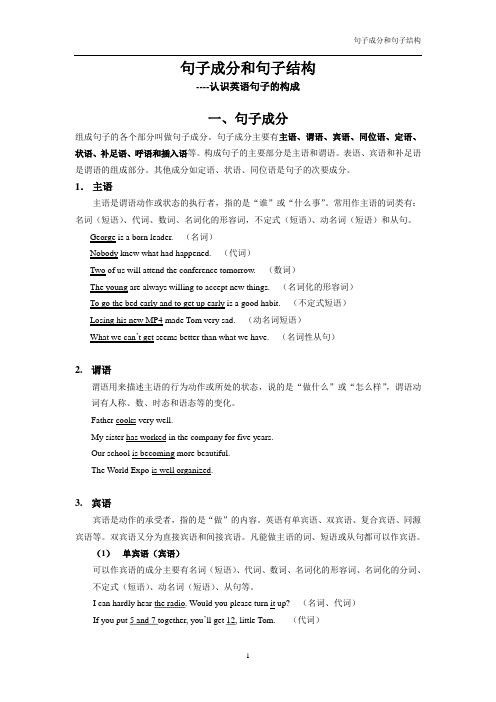
句子成分和句子结构----认识英语句子的构成一、句子成分组成句子的各个部分叫做句子成分。
句子成分主要有主语、谓语、宾语、同位语、定语、状语、补足语、呼语和插入语等。
构成句子的主要部分是主语和谓语。
表语、宾语和补足语是谓语的组成部分。
其他成分如定语、状语、同位语是句子的次要成分。
1.主语主语是谓语动作或状态的执行者,指的是“谁”或“什么事”。
常用作主语的词类有:名词(短语)、代词、数词、名词化的形容词,不定式(短语)、动名词(短语)和从句。
George is a born leader. (名词)Nobody knew what had happened. (代词)Two of us will attend the conference tomorrow. (数词)The young are always willing to accept new things. (名词化的形容词)To go the bed early and to get up early is a good habit. (不定式短语)Losing his new MP4 made Tom very sad. (动名词短语)What we can’t get seems better than what we have. (名词性从句)2.谓语谓语用来描述主语的行为动作或所处的状态,说的是“做什么”或“怎么样”,谓语动词有人称、数、时态和语态等的变化。
Father cooks very well.My sister has worked in the company for five years.Our school is becoming more beautiful.The World Expo is well organized.3.宾语宾语是动作的承受者,指的是“做”的内容。
英语有单宾语、双宾语、复合宾语、同源宾语等。
句子成分和句子结构
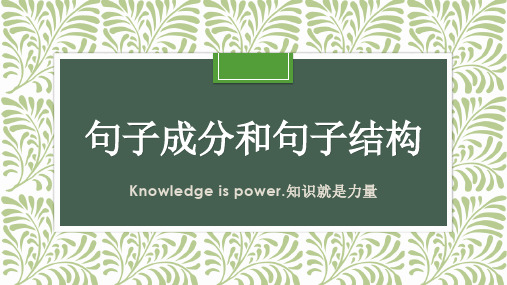
The man next to me is a scientist.
3. 介词短语作定语要后置。 The boy under the tree is Tom.
补语有些动词虽然是及物动词但是只能跟一个宾语还不能表达完整的句子意思宾语后必须加上一个补语成分才能使句意完整所加上的部分就是宾语补足语
句子成分和句子结构
Knowledge is power.知识就是力量
一、相关概念
词类又叫词性,英语单词根据其在句子中的功用,可以分成十个大类。
1 名词 noun n. student 学生 2 代词 pronoun pron. you 你 3 形容词 adjective adj. happy 高兴的 4 副词 adverb adv. quickly 迅速地 5 动词 verb v. cut 砍、割 6 数词 numeral num. three 三 7 冠词 article art. a/an/the 8 介词 preposition prep. at 在... 9 连词 conjunction conj. and 和 10 感叹词 interjection interj. oh 哦
6.状语
状语修饰动词,形容词,副词或者是整个句子,说明动作 或者状态特征的句子成分,叫做状语。
He writes carefully.(认真地写)
He walks slowly.(慢慢地走)
This material is environmentally friendly.(修饰形容词 用副词,作状语。)
句子的成分与结构
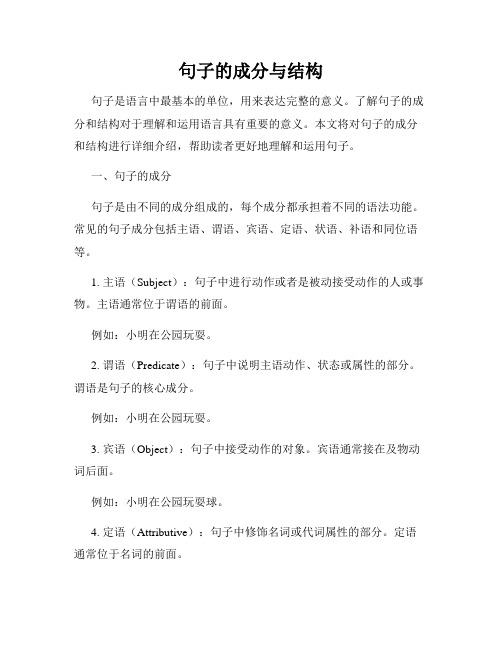
句子的成分与结构句子是语言中最基本的单位,用来表达完整的意义。
了解句子的成分和结构对于理解和运用语言具有重要的意义。
本文将对句子的成分和结构进行详细介绍,帮助读者更好地理解和运用句子。
一、句子的成分句子是由不同的成分组成的,每个成分都承担着不同的语法功能。
常见的句子成分包括主语、谓语、宾语、定语、状语、补语和同位语等。
1. 主语(Subject):句子中进行动作或者是被动接受动作的人或事物。
主语通常位于谓语的前面。
例如:小明在公园玩耍。
2. 谓语(Predicate):句子中说明主语动作、状态或属性的部分。
谓语是句子的核心成分。
例如:小明在公园玩耍。
3. 宾语(Object):句子中接受动作的对象。
宾语通常接在及物动词后面。
例如:小明在公园玩耍球。
4. 定语(Attributive):句子中修饰名词或代词属性的部分。
定语通常位于名词的前面。
例如:美丽的花园。
5. 状语(Adverbial):句子中修饰动词、形容词或副词的成分。
状语可以表示时间、地点、方式、原因等。
例如:我每天早上都去跑步。
6. 补语(Complement):句子中补充说明主语、宾语或谓语的性质或状态的部分。
补语通常位于动词、形容词或名词后面。
例如:他是医生。
7. 同位语(Appositive):句子中用来进一步说明名词或代词的成分。
同位语通常位于名词的后面,并用逗号隔开。
例如:小明,我们的班长,是个好学生。
二、句子的结构句子的结构指的是句子中各个成分的语法关系和排列顺序。
1. 简单句(Simple Sentence):由一个主谓结构构成的句子。
例如:我喜欢看电影。
2. 复合句(Compound Sentence):由两个或者更多的主谓结构构成的句子。
例如:我喜欢看电影,但是他更喜欢读书。
3. 并列句(Coordinate Sentence):由两个或者更多的具有相同地位的分句构成的句子。
例如:我喜欢看电影,他喜欢读书。
4. 从句(Subordinate Clause):不能独立存在的句子,必须依附于主句使用。
句子成分及句子基本结构(共32张PPT)

• We must keep it a secret. (名词)
• I found the book very interesting. (形容词) • Please make yourself at home. (介词短语) • She asked me to lend her a hand. (动词不定式) • He made himself known to them first.(分词短语)
class? • ⑤ Some of the students in the school want to
go swimming, how about you?
(四)表语
• 表语说明主语的性质、特征、状态或身份, 与连系动词一起构成复合谓语。
• We are Chinese. (名词) • I’m not quite myself today. (代词) • Who was the first? (数词) • The war was over. (副词) • He is out of condition. (介词短词) • They seem to know the truth. (动词不定式) • His hobby is playing computer games.(动名词短语) • That is what he told me yesterday. (从词)
When we shall leave hasn’t been decided.(句子)
作主语的有:名词、代词、数词、不定式、 动名词和主语从句。
找出句中主语
• ① The teacher with two of his students is walking into the classroom(.名词)
九大句子成分五大句子结构

will be answered tomorrow.
9. 呼语:称呼用语。
如:Sir、Madam、Your Majesty、Your Highness
3. There be结构的句子扩充:
There be +(定语) +主语+(定语)+(地状) +(时状).
There is a book on the desk. There is an English book on the desk. There is an English book on Chinese history, which was written by a famous British historian, on the desk that stands near the window. 积木式造句法是英语学习中最简洁明了的造 句方法,同学们一定要多加练习、熟练掌握。
We will make him monitor. The good news made us happy. Please let me in. My mother gets me to read English every morning. He kept me waiting for two hours. The news that our team had won the match made
Thanks! Live with passion! Enjoy your study.
grandpa. The pen which I lost yesterday was given to me as
句子成分和句子结构
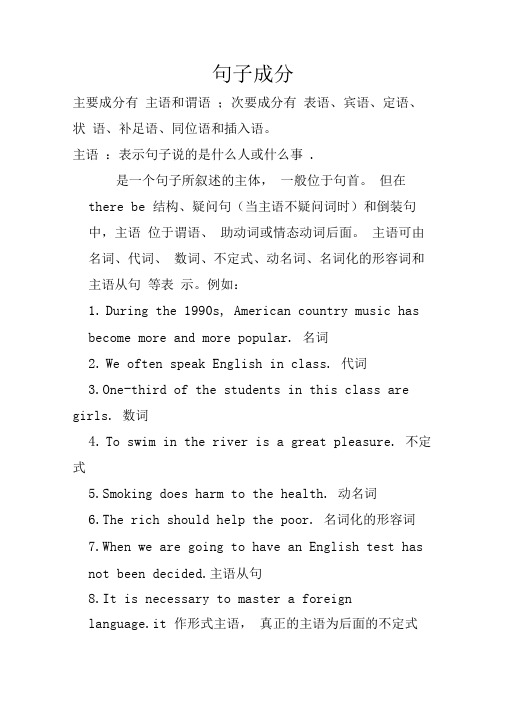
句子成分主要成分有主语和谓语;次要成分有表语、宾语、定语、状语、补足语、同位语和插入语。
主语:表示句子说的是什么人或什么事.是一个句子所叙述的主体,一般位于句首。
但在there be 结构、疑问句(当主语不疑问词时)和倒装句中,主语位于谓语、助动词或情态动词后面。
主语可由名词、代词、数词、不定式、动名词、名词化的形容词和主语从句等表示。
例如:1.During the 1990s, American country music hasbecome more and more popular. 名词2.We often speak English in class. 代词3.One-third of the students in this class are girls. 数词4.To swim in the river is a great pleasure. 不定式5.Smoking does harm to the health. 动名词6.The rich should help the poor. 名词化的形容词7.When we are going to have an English test hasnot been decided.主语从句8.It is necessary to master a foreignlanguage.it 作形式主语,真正的主语为后面的不定式谓语说明主语所做的动作或具有的特征和状态。
动词在句中作谓语,一般放在主语之后。
谓语的构成如下:1、简单谓语:由一个动词或动词短语构成。
如:He practices running every morning.2、复合谓语:(1)由情态动词加动词原形构成。
如:You may keep the book for two weeks.(2)由助动词加动词原形,现在分词,过去分词构成。
如:Do you speak English?They are working in a field.He has caught a bad cold.(3)由系动词加表语构成。
句子成分和句子结构
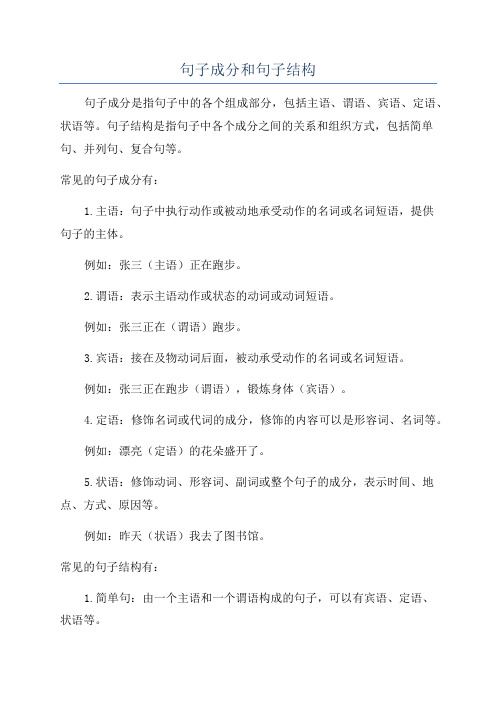
句子成分和句子结构
句子成分是指句子中的各个组成部分,包括主语、谓语、宾语、定语、状语等。
句子结构是指句子中各个成分之间的关系和组织方式,包括简单句、并列句、复合句等。
常见的句子成分有:
1.主语:句子中执行动作或被动地承受动作的名词或名词短语,提供
句子的主体。
例如:张三(主语)正在跑步。
2.谓语:表示主语动作或状态的动词或动词短语。
例如:张三正在(谓语)跑步。
3.宾语:接在及物动词后面,被动承受动作的名词或名词短语。
例如:张三正在跑步(谓语),锻炼身体(宾语)。
4.定语:修饰名词或代词的成分,修饰的内容可以是形容词、名词等。
例如:漂亮(定语)的花朵盛开了。
5.状语:修饰动词、形容词、副词或整个句子的成分,表示时间、地点、方式、原因等。
例如:昨天(状语)我去了图书馆。
常见的句子结构有:
1.简单句:由一个主语和一个谓语构成的句子,可以有宾语、定语、
状语等。
例如:我(主语)喜欢(谓语)跳舞。
2.并列句:由两个或多个分句通过并列关系连接在一起,各个分句地位相等。
例如:我喜欢唱歌,他喜欢跳舞。
3.复合句:由一个主句和一个或多个从句构成的句子,从句在句子中充当其他成分的一部分。
例如:我喜欢唱歌,因为它能让我放松身心。
句子成分和句子结构
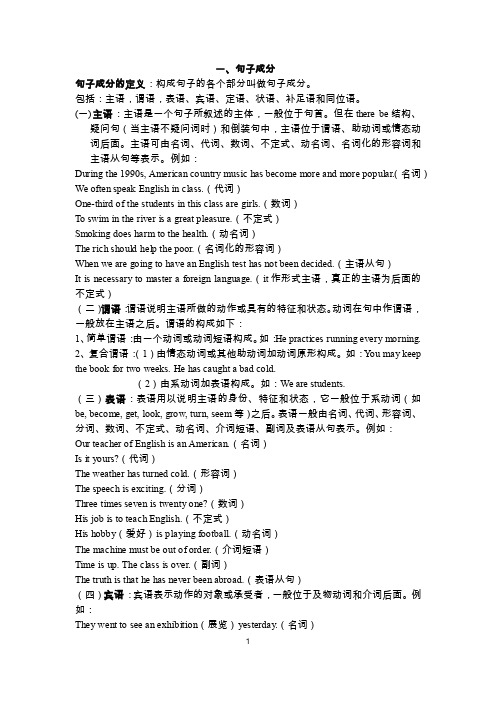
一、句子成分句子成分的定义:构成句子的各个部分叫做句子成分。
包括:主语,谓语,表语、宾语、定语、状语、补足语和同位语。
(一)主语:主语是一个句子所叙述的主体,一般位于句首。
但在there be结构、疑问句(当主语不疑问词时)和倒装句中,主语位于谓语、助动词或情态动词后面。
主语可由名词、代词、数词、不定式、动名词、名词化的形容词和主语从句等表示。
例如:During the 1990s, American country music has become more and more popular.(名词)We often speak English in class.(代词)One-third of the students in this class are girls.(数词)To swim in the river is a great pleasure.(不定式)Smoking does harm to the health.(动名词)The rich should help the poor.(名词化的形容词)When we are going to have an English test has not been decided.(主语从句)It is necessary to master a foreign language.(it作形式主语,真正的主语为后面的不定式)(二)谓语:谓语说明主语所做的动作或具有的特征和状态。
动词在句中作谓语,一般放在主语之后。
谓语的构成如下:1、简单谓语:由一个动词或动词短语构成。
如:He practices running every morning.2、复合谓语:(1)由情态动词或其他助动词加动词原形构成。
如:Y ou may keep the book for two weeks. He has caught a bad cold.(2)由系动词加表语构成。
句子的成分及结构

句子的成分句子是按照一定的语法或句法结构组成的。
组成句子的各个部分叫做句子的成分,主要包括:主语、谓语、宾语、定语、状语、补语、表语、同位语。
主语和谓语是句子的主体部分。
主语The Subject主语是谓语讲述的对象,表示句子所说的是“什么人”或“什么事物”,一般由名词、代词、数词,不定式,动词ing形式或主语从句等充当。
1 Anne is from Australia.2 Is Lucy an American girl ?3 She often goes to the movies.4 We study in No.1 Middle School.5The classroom is very clean. 6 Three plus five equals eight.7 To teach them English is my job. 8 Seeing is believing .眼见为实9 What Peter said was right .注意:在有些句子中需要用it作形式主语。
例如:1 It is very important to master a foreign language .2 It was right that you told me the truth .谓语The Predicate说明主语“做什么”。
谓语(谓语部分里主要的词)必须用动词。
谓语和主语在“人称”和“数”两方面必须一致。
谓语一般在主语后面。
1 He has a toothache.2 We study hard.3 We have finished the job.4 He can speak English.宾语The Object表示动作、行为的对象,由名词、代词,不定式,动名词或宾语从句等充当,和及物动词一起说明主语“做什么”。
一般在谓语之后。
1 All of us like him.2 He's playing soccer.3 Can I ask some questions?4 She is playing the piano now.5 Lucy likes to sleep in the open air.6 We enjoy living in China.7 I don't know who is Jim .8 I don’t mind answering your question.注意:在有些句子中需要用it作形式宾语。
句子成分及句子结构
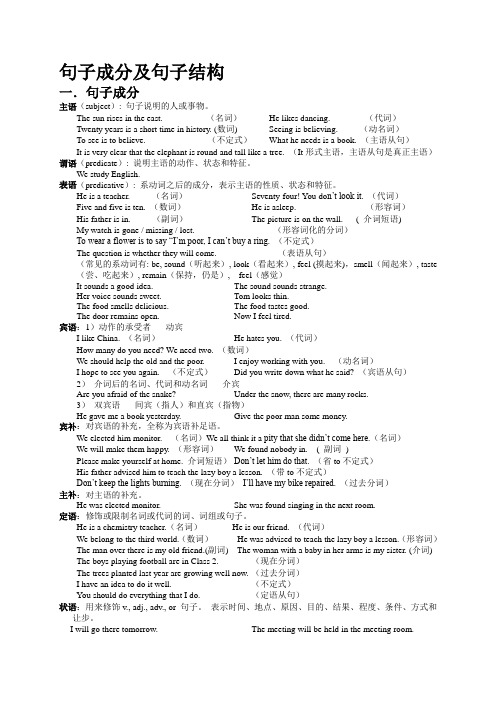
句子成分及句子结构一.句子成分主语(subject): 句子说明的人或事物。
The sun rises in the east. (名词)He likes dancing. (代词)Twenty years is a short time in history. (数词) Seeing is believing. (动名词)To see is to believe. (不定式)What he needs is a book. (主语从句)It is very clear that the elephant is round and tall like a tree. (It形式主语,主语从句是真正主语)谓语(predicate): 说明主语的动作、状态和特征。
We study English.表语(predicative): 系动词之后的成分,表示主语的性质、状态和特征。
He is a teacher. (名词)Seventy-four! You do n’t look it. (代词)Five and five is ten. (数词)He is asleep. (形容词)His father is in. (副词)The picture is on the wall. ( 介词短语)My watch is gone / missing / lost. (形容词化的分词)To wear a flower is to say “I’m poor, I can’t buy a ring. (不定式)The question is whether they will come. (表语从句)(常见的系动词有: be, sound(听起来), look(看起来), feel (摸起来),smell(闻起来), taste (尝、吃起来), remain(保持,仍是), feel(感觉)It sounds a good idea. The sound sounds strange.Her voice sounds sweet. Tom looks thin.The food smells delicious. The food tastes good.The door remains open. Now I feel tired.宾语:1)动作的承受者-----动宾I like China. (名词)He hates you. (代词)How many do you need? We need two. (数词)We should help the old and the poor. I enjoy working with you. (动名词)I hope to see you again. (不定式)Did you write down what he said? (宾语从句)2)介词后的名词、代词和动名词-----介宾Are you afraid of the snake? Under the snow, there are many rocks.3)双宾语-----间宾(指人)和直宾(指物)He gave me a book yesterday. Give the poor man some money.宾补:对宾语的补充,全称为宾语补足语。
句子结构及成分

句子结构及成分一.句子成分现代汉语里一般的句子成分有六种,即主语、谓语、宾语、定语、状语和补语。
英语的基本成分有七种:除主语(subject)、谓语(predicate)、、宾语(object)、定语(attribute)、状语(adverbial) 和补语(complement)之外还有表语(predicative)(同位语)。
许国璋英语中划句子成分的符号主语在下面划一直线谓语在下面划曲线宾语在下面划双横线定语在下面划虚线(一行点使我们想到一排钉子,钉谐音为“定语” 的“定”)状语下面为短横线(短横线使我们想到短木桩,木桩撞(状)钟)补语上一短横,下一短横(下一短横好像是为了弥补上面短横间的空隙)同位语上下双曲线,(虽都有曲折,上下位置基本相同)1.主语主语是一个句子所叙述的主体,一般位于句首,通常由名词性的词来充当。
可由1。
名词、2.代词、3。
数词、4.名词化的形容词(如the rich)5。
不定式、6。
动名词、7。
主语从句等表示.The sun rises in the east.(名词)He likes dancing。
(代词)Twenty years is a short time in history。
(数词)Seeing is believing.(动名词)To see is to believe. (不定式)What he needs is a book. (主语从句)It is very clear that the elephant is round and tall like a tree. (It形式主语,主语从句是真正主语)练习1. 在下面句子的主语下面划横线,并说出由什么充当1.During the 1990s,American country music has become more and more popular。
2.We often speak English in class.3.One-third of the students in this class are girls。
句子成分及句子结构
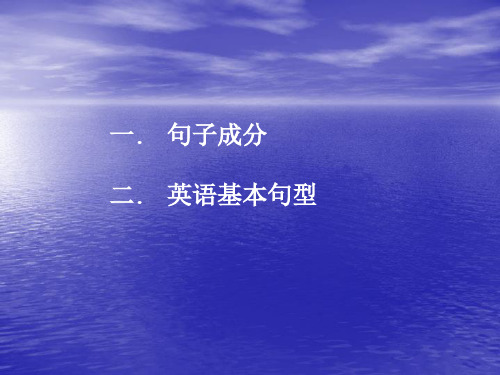
She is happy.
Everybody is here.
They are at home now.
My job is to teach English.
Seeing is believing.
状态:seem, appear, prove ---
感官:smell, feel, taste, sound, look ---
(四) 挑出下列句中的宾语补足语 ① She likes the children to read newspapers and books in the reading-room. ② He asked her to take the boy out of school. ③ She found it difficult to do the work. ④ They call me Lily sometimes. ⑤ I saw Mr Wang get on the bus.
• 它可以由名词,形容词,副词,介词短语,不定式,现 在分词和过去分词充当. • If you let me go, I’ll make you king.
• Leave the door open.
•We found John out when we arrived.
• Make yourself at home.
• 1.主语:主语是在句子中说明全句中心主题的 部分.一般由名词,代词,不定式,动名词或从 句充当.它的位置一般在句首.
The girl is pretty. Reading is useful. To see is to believe. They are good friends.
谓语:
- 1、下载文档前请自行甄别文档内容的完整性,平台不提供额外的编辑、内容补充、找答案等附加服务。
- 2、"仅部分预览"的文档,不可在线预览部分如存在完整性等问题,可反馈申请退款(可完整预览的文档不适用该条件!)。
- 3、如文档侵犯您的权益,请联系客服反馈,我们会尽快为您处理(人工客服工作时间:9:00-18:30)。
2. 疑问句 用来提出问题,它又可 分为四类:
一般疑问句 (1) Do they like playing PC games? --- Yes, they do. (2) Have you a wrist watch? --- No, I haven’t.
特殊疑问句 (1)Who is singing in the next dormitory? (2)What are you doing now? (3) Why do they like playing golf? (4) When did you get the very job?
SvoO ①.I taught you English grammar. ②.Someone left you this note. ③.David showed me the way.
SVOC ①.We elected him our spokesman. ②.They painted the walls creamy white. ③.The directors appointed him sales manager.
3. 祈使句
(1) Copy the exercise in your notebook. (2)Don’t be afraid of making grammatical mistakes. (3) Let’s take the child to the park!
4.感叹句
(1) (2) (3) (4) (5)
2. 并列句(Compound Sentence) 它包括两个或两个以上并列而又 相互独立的简单句。其结构为 “SP+连词+SP”。 ◆连接两个概念 常见的and, so, therefore, not only…but(also), neither… nor等。如:
(1) I think, therefore I exist. (2) She not only writes her own plays, she also acts in them. (3) He neither speaks English, nor understands it.
(6) Commerce with other countries is very important to us. (7) Please give me a knife to cut with. (8) The boy, tired, hungry and thirsty, fell down on the beach.
3.宾语(Object) 宾语是及物动词的对象和内容。 不及物动词后不能接宾语。介词后面的名词或代 词叫做介词宾语。可有n,pron,num或与之相当 的结构担任。如:
(1) Would you mind coming earlier tomorrow? (2) I don’t know where he has gone. (3) The sun gives us light and warmth.
一 英语语法概要
Members of the sentence
1. The students of Class Four are attentively reading the book written by Lu Xun.
2. Behaviorists suggest that the child who is raised in an environment where there are many stimuli which develop his or her capacity for proper responses will experience greater intellectual development.
句子的种类
一 按照用途分为四类: 1.陈述句(肯定或否定)如:
(1) We love our motherland. (2) As they say, when the age is in, the wit is out. (3) We can’t live without air and water.
(5) What we shall do next is not yet decided. (6) It doesn’t matter whether
he will come or not.
2>. 谓语(Precicate) 它是说 明主语的动作或状态的部分.除了 特殊的倒装结构一般位于主语后。 ①His father is a fireman. ②The children laughed. ③We should pay attention to English idioms.
◆ 表示矛盾或对照 常见的有but, yet, still, however, while, whereas 等。
(1) She felt ill, but she still went to work. (2) I drink black coffee while he prefers it with cream.
4. 补语(Complement) 用于补充说明主 语或宾补。常由adj,n或相当的结构充当。
①.He doesn’t believe the story true. ②.The doctor advised her to stay in bed for a week. ③.They saw her walking into the bookstore. (4) He was considered to be the best player.
1>. 主语(Subject) 它是句子的主体,是“什么 人,什么事,什么物”的问题。常由 n,pron,num,to-do,-ving,clause 担任。
①.Professor Wang is a wellknown scholar. ②.I read English newspaper every day. ③.To become a professor has been his ambition. ④. Smoking is harmful to health.
5. 表语(Predicative) 它在联系动词之后 表示主语的性质、特征、状态或身份的部分。 可有n,pron,adj,adv,num,to-do,ving,clause担任。如:
①.Susan is always careless. ②.Her job is to look after the children. ③.His job is teaching you how to use the machine. ④.The key question is how we should solve the problem.
SVC ①.He is in good health. ②.These flowers smell fragrant. ③.My brother has become an engineer.
SVO ①.I want a return ticket. ②.Nobody could answer the question. ③.The train is building up speed.
并列复合句 指的是并列句中含有一个或多个从 句。如: (1) Altogether Beethoven
wrote nine symphonies, but most of them were written after he had lost his hearing.
简单句的扩展成份
简单句的主语、宾语可以加上一 个短语(如定语)来扩展,及物 动词或不及物动词也可以与其它 短语(如状语)连用进行扩展。 如下:
(1) Shall we go by bus or by train? (2) Do you love chess or snooker? (3) Peter smokes a lot, doesn’t he? (4)Linda isn’t a college student, is she?
选择疑问句/反义疑问句
6.定语(Attributive) 用来限定或 修饰名词或代词。通常由形容词或与 之相当的结构担任。 它可以是一个词或是几个词或者 一个词组,或者是个句子。位置比较 灵活,可在名词前后。 (1)The yellow bike is mine. (2) A very valuable bronze Egyptian cat.
(3) The man who gave us a report yesterday was a model worker. (4) This is a book which tells rocket technology. (5) After all, he is a fiveyear-old boy.
源自I bought a rain coat with a warm lining. The dog jumped through the window. He is saving up to buy a mobile phone. A bright little boy with rosy cheeks put three bottles of milk quietly on my doorstep before seven o’clock. He worked like a madman in the garden on Saturday. The young girl with long black hair seems to be very happy.
◆ 表示两者选其一 常见的有or, otherwise, or else, either…or. 如:
(1) Either he is to blame or I am. (2) You must go to work or/ or else/ otherwise you will lose your job.
